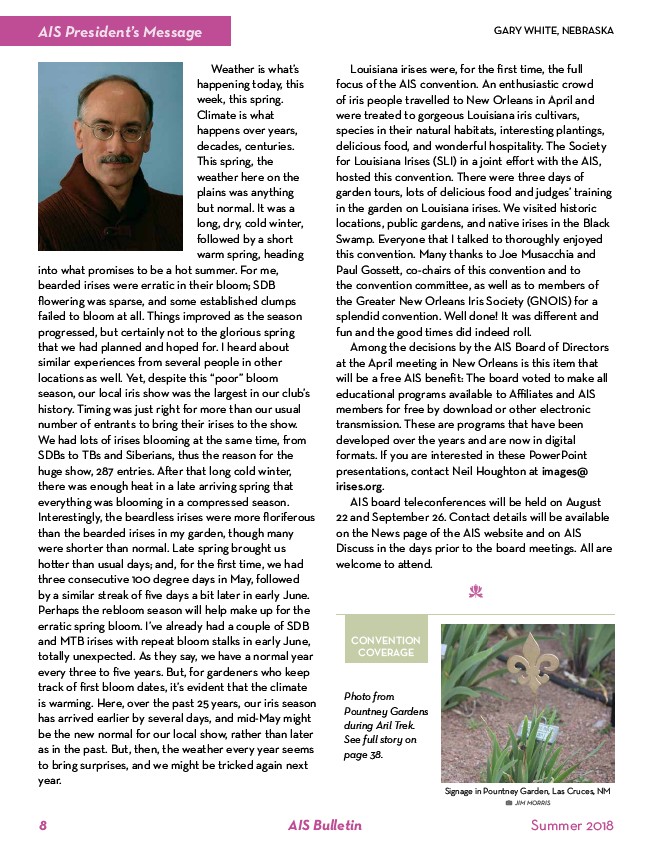
AIS President’s Message GARY WHITE, NEBRASKA
Weather is what’s
happening today, this
week, this spring.
Climate is what
happens over years,
decades, centuries.
This spring, the
weather here on the
plains was anything
but normal. It was a
long, dry, cold winter,
followed by a short
warm spring, heading
into what promises to be a hot summer. For me,
bearded irises were erratic in their bloom; SDB
flowering was sparse, and some established clumps
failed to bloom at all. Things improved as the season
progressed, but certainly not to the glorious spring
that we had planned and hoped for. I heard about
similar experiences from several people in other
locations as well. Yet, despite this “poor” bloom
season, our local iris show was the largest in our club’s
history. Timing was just right for more than our usual
number of entrants to bring their irises to the show.
We had lots of irises blooming at the same time, from
SDBs to TBs and Siberians, thus the reason for the
huge show, 287 entries. After that long cold winter,
there was enough heat in a late arriving spring that
everything was blooming in a compressed season.
Interestingly, the beardless irises were more floriferous
than the bearded irises in my garden, though many
were shorter than normal. Late spring brought us
hotter than usual days; and, for the first time, we had
three consecutive 100 degree days in May, followed
by a similar streak of five days a bit later in early June.
Perhaps the rebloom season will help make up for the
erratic spring bloom. I’ve already had a couple of SDB
and MTB irises with repeat bloom stalks in early June,
totally unexpected. As they say, we have a normal year
every three to five years. But, for gardeners who keep
track of first bloom dates, it’s evident that the climate
is warming. Here, over the past 25 years, our iris season
has arrived earlier by several days, and mid-May might
be the new normal for our local show, rather than later
as in the past. But, then, the weather every year seems
to bring surprises, and we might be tricked again next
year.
Louisiana irises were, for the first time, the full
focus of the AIS convention. An enthusiastic crowd
of iris people travelled to New Orleans in April and
were treated to gorgeous Louisiana iris cultivars,
species in their natural habitats, interesting plantings,
delicious food, and wonderful hospitality. The Society
for Louisiana Irises (SLI) in a joint effort with the AIS,
hosted this convention. There were three days of
garden tours, lots of delicious food and judges’ training
in the garden on Louisiana irises. We visited historic
locations, public gardens, and native irises in the Black
Swamp. Everyone that I talked to thoroughly enjoyed
this convention. Many thanks to Joe Musacchia and
Paul Gossett, co-chairs of this convention and to
the convention committee, as well as to members of
the Greater New Orleans Iris Society (GNOIS) for a
splendid convention. Well done! It was different and
fun and the good times did indeed roll.
Among the decisions by the AIS Board of Directors
at the April meeting in New Orleans is this item that
will be a free AIS benefit: The board voted to make all
educational programs available to Affiliates and AIS
members for free by download or other electronic
transmission. These are programs that have been
developed over the years and are now in digital
formats. If you are interested in these PowerPoint
presentations, contact Neil Houghton at images@
irises.org.
AIS board teleconferences will be held on August
22 and September 26. Contact details will be available
on the News page of the AIS website and on AIS
Discuss in the days prior to the board meetings. All are
welcome to attend.
d
CONVENTION
COVERAGE
Signage in Pountney Garden, Las Cruces, NM
, jim morris
Photo from
Pountney Gardens
during Aril Trek.
See full story on
page 38.
8 AIS Bulletin Summer 2018